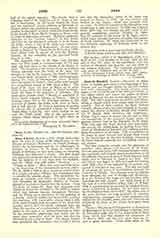

Anne de Beaupre, SAINTE .—Devotion to Saint Anne, in Canada, goes back to the beginning of New France, and was brought thither by the first settlers and early missionaries. The hardy pioneers soon began to till the fertile soil of the Beaupre hillside; in the region which now forms the parish of Sainte Anne de Beaupre the first houses date from the year 1650. Nor was it long before the settlers built themselves a chapel where they might meet for Divine worship. One of their number, the Sieur Etienne Lessard, offered to give the land required at the spot which the church authorities should find suitable. On March 13, 1658, therefore, the missionary, Father Vignal, came to choose the site and to bless the foundations of the proposed chapel which, by general consent, was to be dedicated to St. Anne. That very day the Saint showed how favorably she viewed the undertaking by healing Louis Guimont, an inhabitant of Beaupre, who suffered terribly from rheumatism of the loins. Full of confidence in St. Anne, he came forward and placed three stones in the foundations of the new building, whereupon he found himself suddenly and completely cured of his ailment.
This first authentic miracle was the precursor of countless other graces and favors of all kinds. For two centuries and a half the great wonderworker has ceaselessly and lavishly shown her kindness to all the sufferers who from all parts of North America flock every year to Beaupre to implore her help. The old church was begun in 1676, and used for worship until 1876, when it was replaced by the present one, opened in October of that year. This last was built of cut stone, by means of contributions from all the Catholics of Canada. The offerings made by pilgrims have defrayed the cost of fittings and decoration. It is two hundred feet long, and one hundred wide, including the side chapels. Leo XIII raised it to the rank of a minor basilica May 5, 1887; on May 19, 1889, it was solemnly consecrated by Cardinal Taschereau, Archbishop of Quebec. It has been served by the Redemptorists since 1878. On either side of the main doorway are huge pyramids of crutches, walking-sticks, bandages, and other appliances left behind by the cripples, lame, and sick, who, having prayed to St. Anne at her shrine, have gone home healed.
RELICS.—The canons of Carcassonne, at the request of Monseigneur de Laval, first Bishop of Quebec, sent to Beauprg a large relic of the finger-bone of Saint Anne, which was first exposed for veneration on March 12, 1670, and has ever since been an object of great devotion. Three other relics of the saint have been added in later times to the treasures of this shrine. In 1892 Cardinal Taschereau presented the Great Relic to the basilica, the wrist-bone of St. Anne. It measures four inches in length, and was brought from Rome by Msgr. Marquis, P.A.
PILGRIMAGE.—The pilgrimage to Beaupre has not always had the importance which it has gained in our time. Only in the last quarter of the nineteenth century did it attain to the growth, organization, and fame which now render it comparable with the great pilgrimage to Lourdes. Until 1875 the yearly number of pilgrims did not exceed 12,000, but to judge by the heap of crutches left at the saint’s feet, there must always have been many marvellous cures wrought at Beaupre. More favorable conditions have made possible the truly wonderful growth of these pilgrimages of late years. The strong impulse given by Cardinal Taschereau and his suffragans; the zeal of the Canadian clergy in organizing parish and confraternity pilgrimages; the many new railways, and, particularly, the line between Quebec and Beaupre (21 miles); the “Annales de la Bonne Sainte Anne”, more than 40,000 copies of which are published every month—all these have combined to favor the trend of pilgrimage to the shrine of Beaupre. Moreover, devotion to St. Anne is today more than ever the devotion of the Canadians.
The following figures will give an idea of the growth of the pilgrimages during the last twenty-five years: In 1880, 36,000 pilgrims visited the shrine; in 1890, 105.000; in 1900, 135,000; in 1905, 168,000.
C. LECLERC

